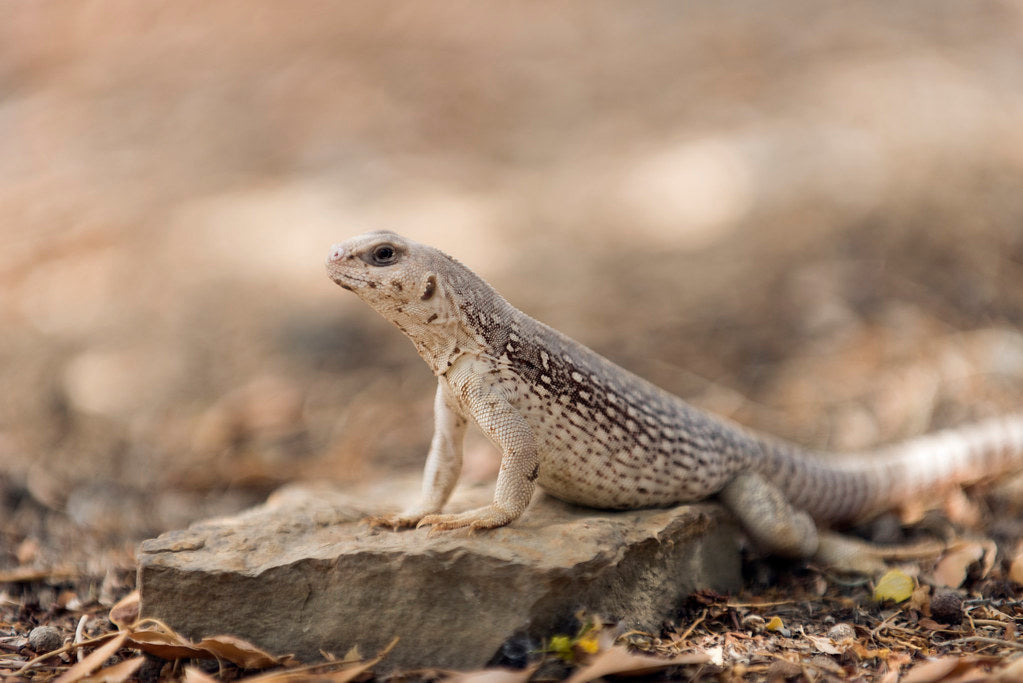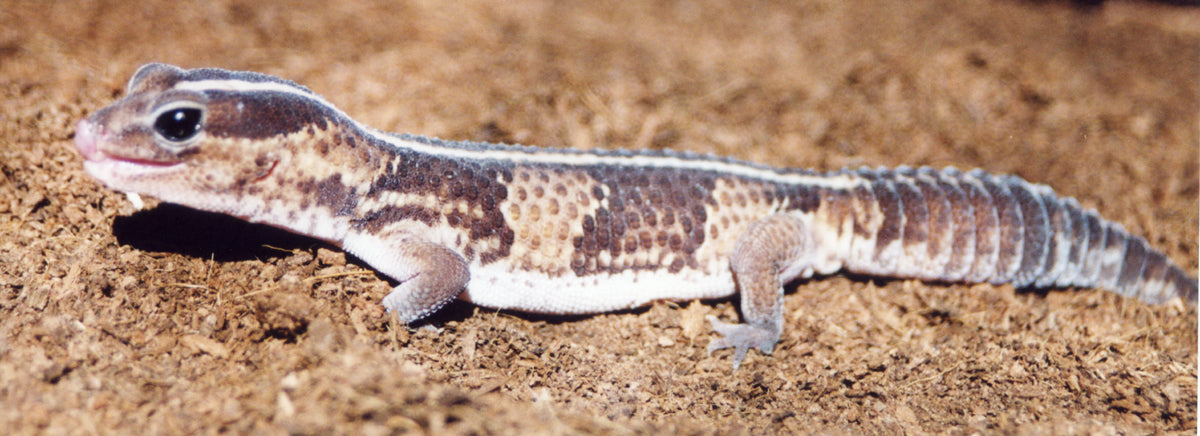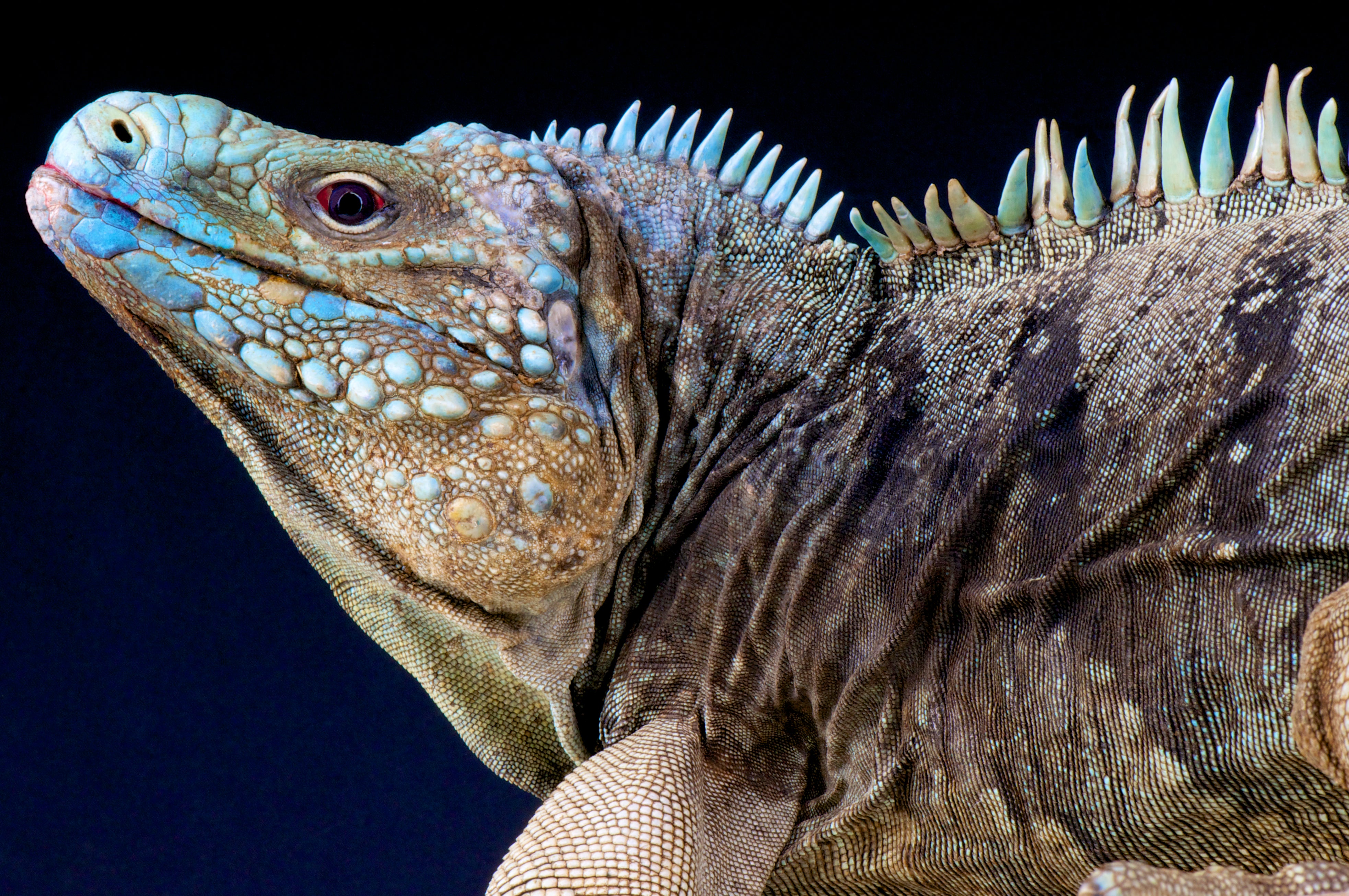Desert iguanas (Dipsosaurus dorsalis) are 16”-18” long, diurnal, terrestrial lizards native to the deserts of the southwestern United States and northwestern Mexico. Their territory often coincides with the presence of a major food source, the creosote bush (Larrea tridentata).
Desert iguanas are slender but well-built lizards with a small, round head, short neck, and a long tail. Their base color is gray-beige, with pale spots, a ringed tail, and a pale belly. Males and females are typically very similar in appearance.
Desert iguanas are very uncommon in the pet trade, and have very specific care requirements to thrive in captivity. They are generally considered intermediate-level pet reptiles. With good care, they can live at least 14 years.
How much space do desert iguanas need?
A single desert iguana should be housed in no smaller than a 36”L x 24”W x 24”H enclosure. However, if you can provide a larger enclosure, like a 48" x 24" x 24", do it! Providing a larger enclosure will provide your pet with more opportunities to exercise, explore, and demonstrate natural behaviors.
Housing multiple desert iguanas in the same enclosure is possible if you have a group of females, but is not required for wellbeing. If you choose to house more than two together, you will need to increase the size of the enclosure. Males should never be housed together.
Do desert iguanas need UVB?
Yes! Desert iguanas are diurnal, which means that they are most active during the day, and naturally exposed to lots of sunlight on a day-to-day basis. This means that they need UVB light as part of their enclosure. The best UVB bulbs for a desert iguana housed in a 36” long enclosure are:
- Zoo Med Reptisun T5 HO 10.0, 22”
- Arcadia Desert 12%, 22”
Use a high-quality reflective T5 HO fixture for the bulb, such as Arcadia or Vivarium Electronics. If the UVB is mounted over mesh, place the basking area so the lizard’s back will be 8-12” below the lamp. If the UVB is mounted inside the enclosure, place the basking area so the lizard’s back will be 14-16” below the lamp.
Note that UVB is blocked by glass and plastic, so you can’t give your lizard UVB by placing its terrarium in front of an open window. Also make sure that your UVB fixture does not have a clear plastic bulb cover.
In addition to UVB, you will need a daylight-spectrum lamp to make sure the enclosure is brightly illuminated. Bright light has been linked to faster growth, better health, and more activity in desert iguanas. Use a strong 6500K LED or T5 HO fluorescent plant grow light for best results.
Desert iguanas should get 10 hours of light per day during winter and 14 hours of light per day during summer. This simulates natural seasonal changes in day length and encourages healthier hormonal rhythms.
What basking temperatures do desert iguanas need?
Desert iguanas like it hot! They should have a basking surface temperature between 140-158°F, with cool side temperatures between 70-85°F. Heating should be turned off at night: nighttime temperatures should be low, preferably below 70°F. Measure your temperatures with an infrared thermometer/temp gun.
Provide heat for your desert iguana by imitating the sun with a couple of halogen heat lamps clustered on one side of the enclosure. Do not use ceramic heat emitters (CHEs), heat mats, red bulbs, or blue bulbs, as these are not as effective. For best results, the basking surface itself should be a large, flat piece of rock.
As part of their seasonal cycle, desert iguanas should be permitted to brumate (the reptile version of hibernation). This helps regulate their hormonal cycle, boost overall health, and is likely to increase longevity. Winter weather can be re-created with a ~104°F basking surface temperature, 68-77°F cool side temperature, and only 4 hours of heat per day.
What humidity levels do desert iguanas need?
Desert iguanas are a truly arid species that don’t need much in the way of enclosure humidity, and too much humidity can harm them. Target average ambient humidity levels between 15-30%, and absolutely no higher than 50%.
They benefit from access to a humid burrow. A good way to do this is to simply moisten the substrate below/inside one of their hideouts. Light misting with a spray bottle every morning is a good way to simulate natural dew and keep your iguana hydrated.
What substrate is good for desert iguanas?
Substrate covers the floor of your lizard’s terrarium and helps make the enclosure more attractive, but it also helps maintain desired humidity levels and provides something for your desert iguana to dig around in.
It’s ideal to use a substrate that imitates the “substrate” that the reptile naturally lives on in the wild. For desert iguanas, that means sand or very sandy soil. We recommend the following substrates for this species:
- Zoo Med ReptiSand
- Exo Terra Desert Sand
- Play sand
Substrate should be at least 6” deep (preferably deeper) and completely replaced every 3-4 months. Remove poop and urates daily, along with contaminated substrate.
What décor can you use in a desert iguana terrarium?
A bare enclosure is a boring enclosure, and although size matters, if there’s nothing inside it, it won’t do much for your desert iguana. Enrichment items that help simulate the reptile’s natural habitat help prevent boredom and encourage your desert iguana to exercise natural behaviors.
At bare minimum, you will need at least one cave/burrow for the iguana to hide in and a flat stone for basking on. However, it’s best to include other items, such as:
- more hiding places
- ledges
- branches
- drought-tolerant, edible plants
What do desert iguanas eat?
Desert iguanas are primarily herbivorous, which means that they eat mostly plants to get the nutrition that they need. Desert iguanas should be able to eat their fill of greens and flowers every day. Approximately 85-90% of their diet should be leafy greens and flowers, with 10-15% consisting of insects. Chop vegetables into bite-sized portions to help prevent choking.
For a healthy, happy desert iguana, offer as much dietary variety as you can!
Leafy greens for desert iguanas: collard greens, cactus pads, spring mix, arugula, kale, alfalfa, bok choy, carrot greens, spinach, dandelion greens, hibiscus greens, turnip greens, mustard greens, parsley, romaine lettuce, escarole, watercress, clover
Other vegetables for desert iguanas: broccoli, rapini, zucchini, cauliflower, sweet potato, bell pepper, squash, carrots, okra, sprouts, pea pods, green beans, shredded carrots
Edible flowers such as dandelion and nasturtium can also be offered. Desert iguanas especially like the color yellow!
Insects such as crickets, roaches, and darkling beetles can be offered 1x/week as a source of protein and fat. However, make sure not to let them eat too many insects, as they require a low-protein diet, and high protein is very bad for their health.
Supplements
You will also need calcium and vitamin supplements to prevent your lizard from developing a deficiency. We recommend Repashy SuperVeggie lightly dusted on all salads and Repashy Supercal LoD on all insects. It’s okay to occasionally skip a dusting.
Dusting salads with a probiotic supplement like Nature Zone Bearded Dragon Probiotics & Prebiotics may also be beneficial for promoting healthy digestion.
Water
Although desert iguanas are desert animals, they still need access to fresh water. Provide a small water bowl where your lizard can always get a drink when needed. Keep the water clean and scrub the bowl with a reptile-safe disinfectant weekly, or whenever it becomes soiled.
Do desert iguanas like to be handled?
Few reptiles actually “like” to be held. Some desert iguanas learn to tolerate human interaction well, but others are skittish and prefer to be left alone. If you want to interact with your pet, start with hand-feeding. Treats like flowers work well for this.
Never grab the lizard from above — instead, approach from the side and scoop from below. Support as much of its body as possible, especially its feet. Start with very short handling sessions in the beginning, then gradually make them longer as your pet becomes more accustomed to you.
*This care sheet contains only very basic information. Although it’s a good introduction, please do further research with high-quality sources to obtain additional information on caring for this species.
"Desert iguana (Dipsosaurus dorsalis)" by Joshua Tree National Park is marked with CC PDM 1.0




Leave a comment
This site is protected by hCaptcha and the hCaptcha Privacy Policy and Terms of Service apply.